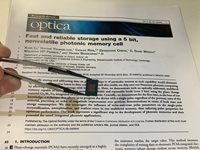Dec 21 2018
A new method demonstrated by scientists can store more optical data in a smaller space than was earlier conceivable on-chip. This method enhances the phase-change optical memory cell, which uses light to write and read data, and could provide a faster, more power-efficient form of memory for computers.
 A new technique allows more optical data to be stored in a smaller space than was previously possible on-chip. This demonstration is an important step toward an all-optical computer. (Image credit: Oxford University
A new technique allows more optical data to be stored in a smaller space than was previously possible on-chip. This demonstration is an important step toward an all-optical computer. (Image credit: Oxford University
In Optica, The Optical Society’s journal for high impact research, scientists from the Universities of Oxford, Exeter, and Münster illustrate their new method for all-optical data storage, which could help meet the increasing need for more computer data storage.
Instead of using electrical signals to store data in one of two states—a zero or one—like present-day computers, the optical memory cell makes use of light to store information. The scientists showed optical memory with over 32 states, or levels, the equivalent of 5 bits. This is a vital step toward an all-optical computer, a long-term goal of various research groups in this field.
“Optical fibers bring light-encoded data to our homes and offices, but that information is transformed to electronic signals once inside computers,” said research team leader Harish Bhaskaran from Oxford. “By bringing the speed of light-based data transmission to the circuit boards that run computers, our all-optical memory could enable a hybrid computer chip that interacts with data both optically and electrically.”
The new study is part of a large project called Fun-COMP, for Functionally-scaled Computing technology that brings industrial and academic partners together to create groundbreaking hardware technologies.
Writing data with light
Light is used by the optical memory cell to encode information in a phase change material, a group of materials used to make re-writable CDs and DVDs. A laser heats portions of a phase change material, which causes it to shift between states where all the atoms are disordered or ordered. As these two states display various optical indices of refraction, the data can be read using light.
Phase change materials are capable of storing data for a prolonged period as they remain in the disordered or ordered state until illuminated again with the particular type of laser light first used to write the data. Combining different ratios of ordered and disordered states in an area of the material permits information to be stored in a continuum of levels rather than just a zero and a one as in traditional electronic memory.
“Although our team has previously used this approach to optical memory, we’ve now been able to push the resolution limits of this memory cell by storing a larger number of intermediate states between zero and one,” said Nathan Youngblood, a member of the research team. “This allowed us to store information in 34 levels, while only 10 could be achieved previously.”
The scientists accomplished the better resolution by using a new method they formulated that uses laser light with a single, double-stepped pulse—two pulses joined into a rectangular-shaped pulse—to exactly control the melting and the crystallization of the material.
Instead of heating the material with a single laser pulse, we shape the pulse in a way that allows us to control the material’s temperature over time. This provides the ability to adjust how that material interacts with light and the state it will reach after heating. It also greatly speeds up the writing process because we can change the material’s state with just one laser pulse instead of the hundreds or thousands of pulses required previously.
Xuan Li, Study First Author, University of Oxford
Multi-level memory storage
In the paper, the scientists revealed that they could use their method to reliably encode data on 34 levels, which is more than the 32 levels necessary to accomplish 5-bit programming. “This accomplishment required understanding the interaction between the light and the material perfectly and then sending exactly the right sort of laser pulse necessary to achieve each level,” said Bhaskaran. “We solved an extraordinarily difficult problem.”
The new method could help surpass one of the bottlenecks restricting the speed of present-day computers: the link between the memory and the processor.
A lot of work has gone into improving the communication between these two units using fiber optics. However, linking these two units optically still requires expensive electro-optical conversions at both ends. Our memory cell could be used in a hybrid optical-electrical setup to eliminate the need for that conversion on the memory side by allowing data to be stored and retrieved optically.
Harish Bhaskaran, Research Team Leader, University of Oxford
Going forward, the scientists want to combine many memory cells and individually program them, which would be necessary to make a working memory chip for a computer. The study groups have been involved closely with Oxford University Innovation, the University’s Innovation arm, to promote commercial opportunities arising from their research on photonic memory cells. The scientists say that they can already reproduce the devices easily but will need to formulate light signal processing methods to incorporate several optical memory cells.